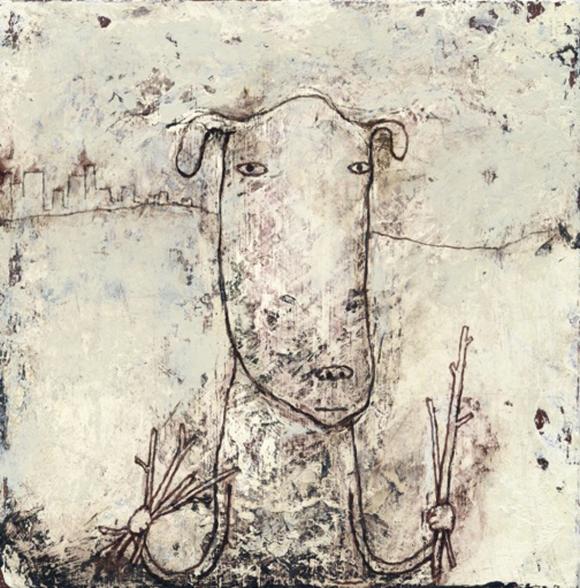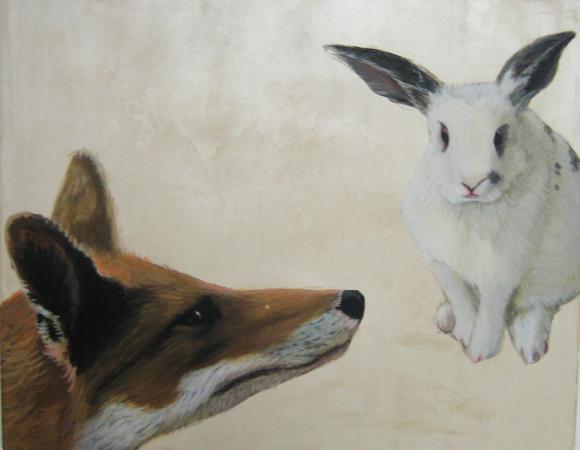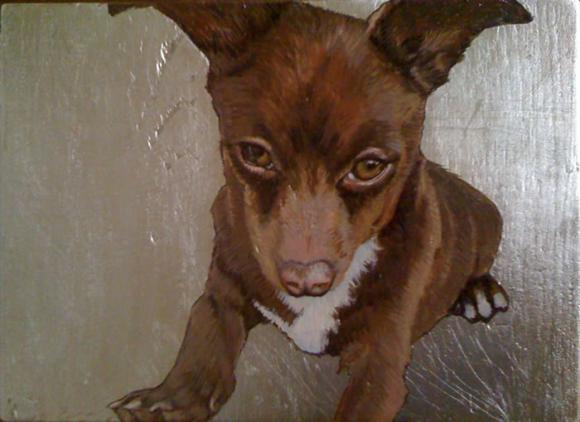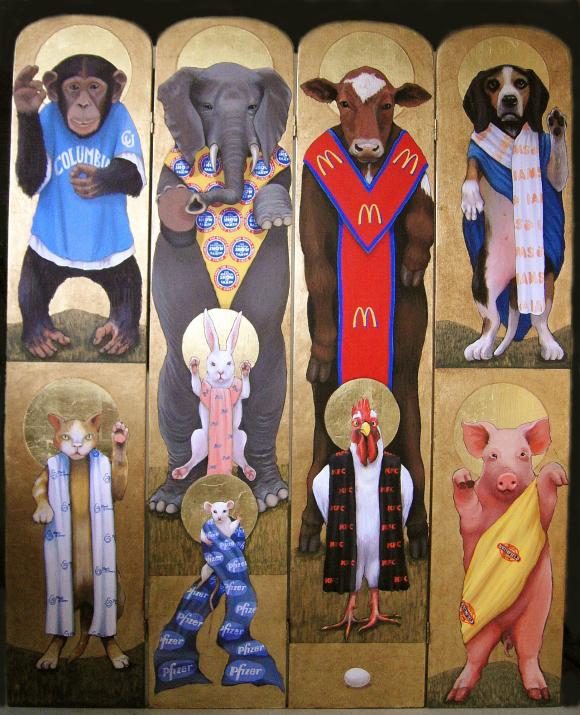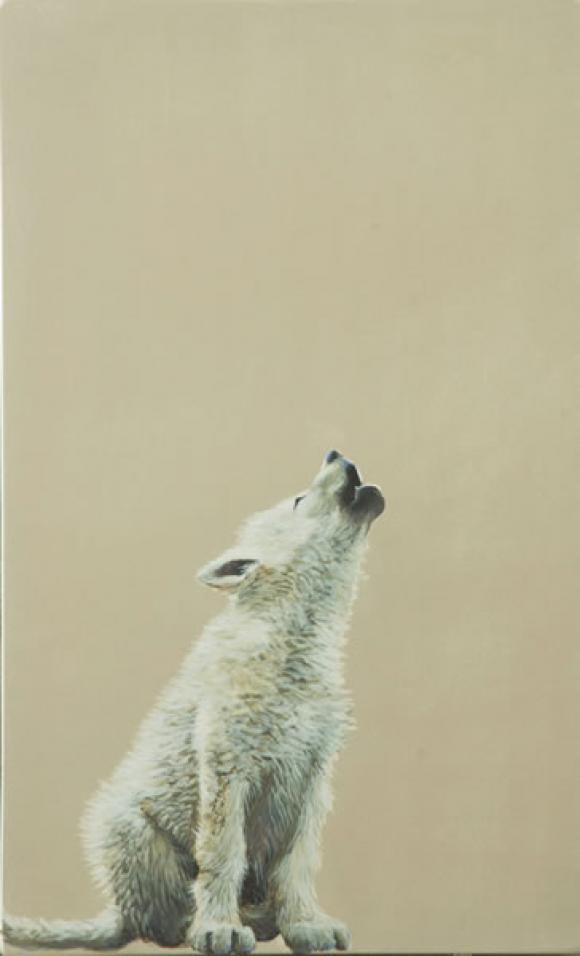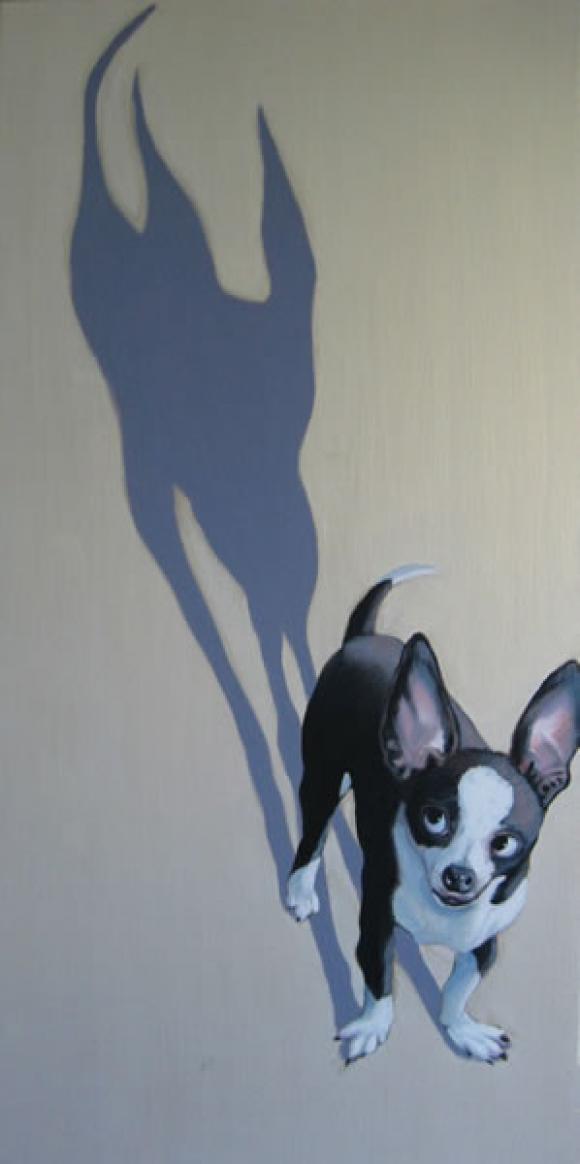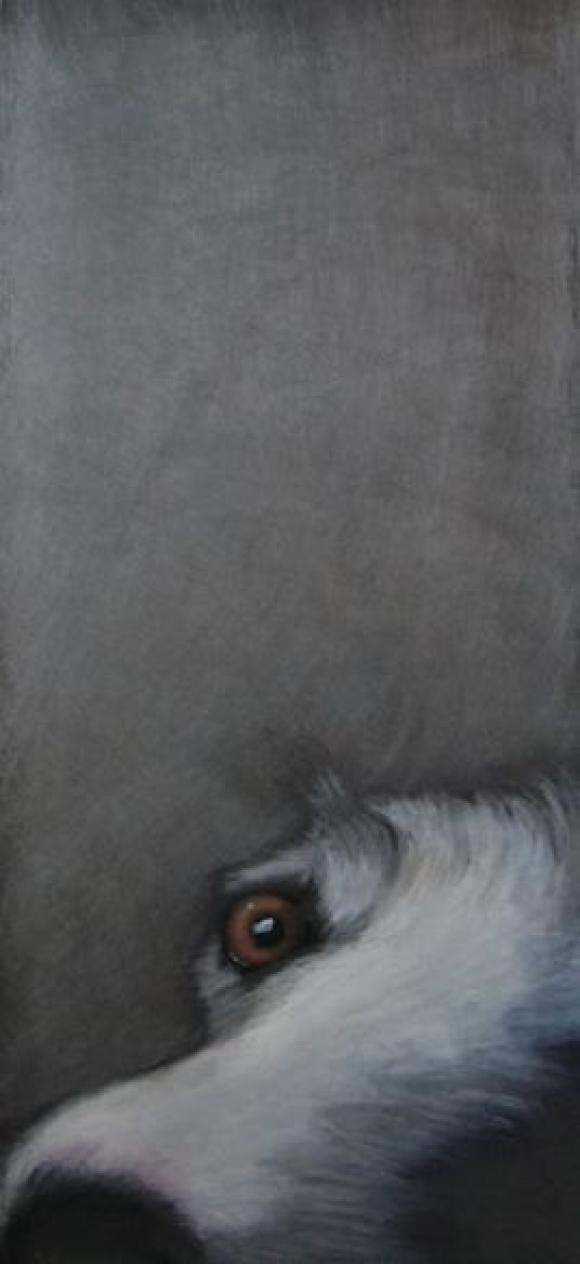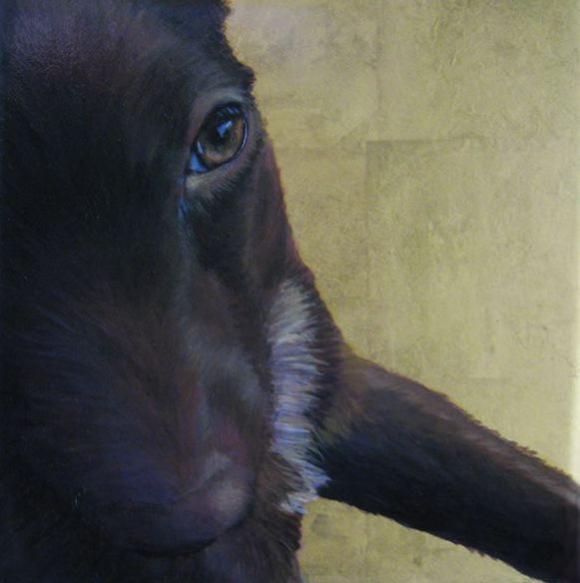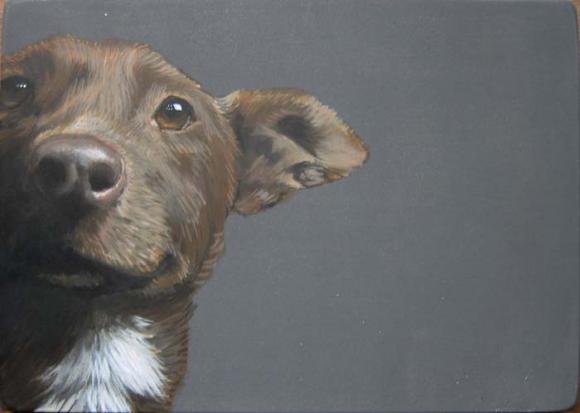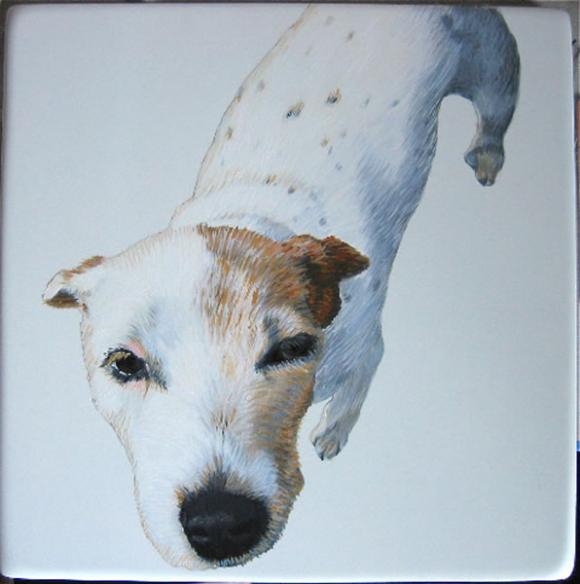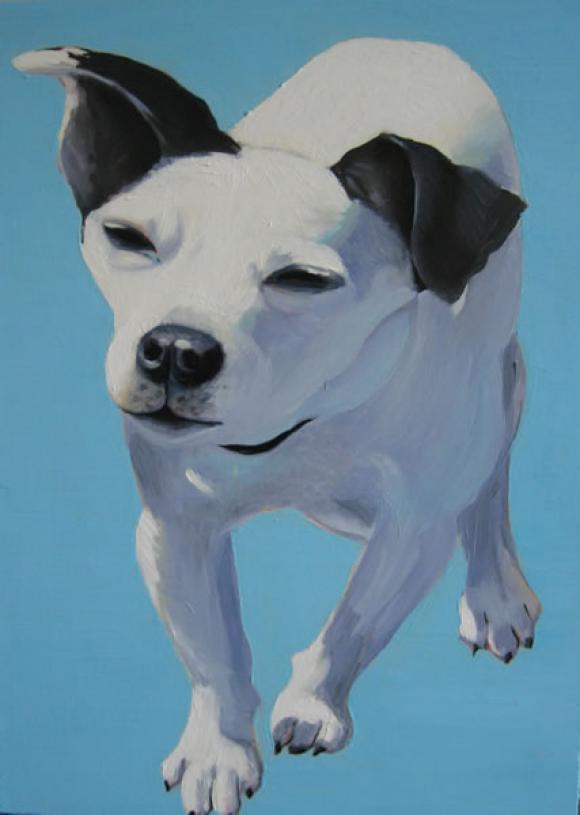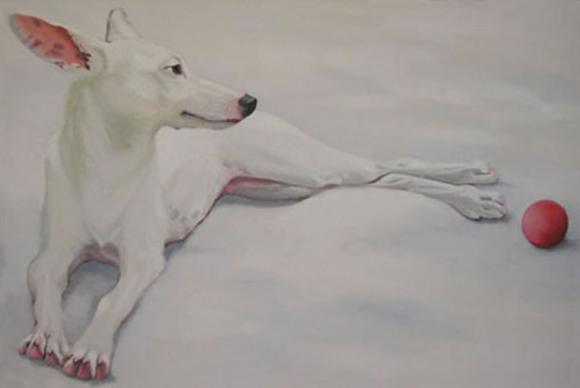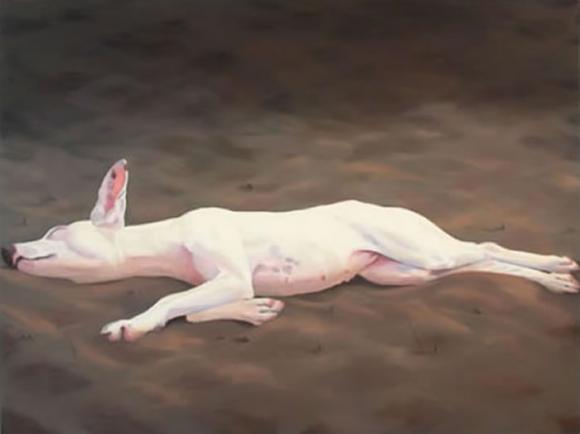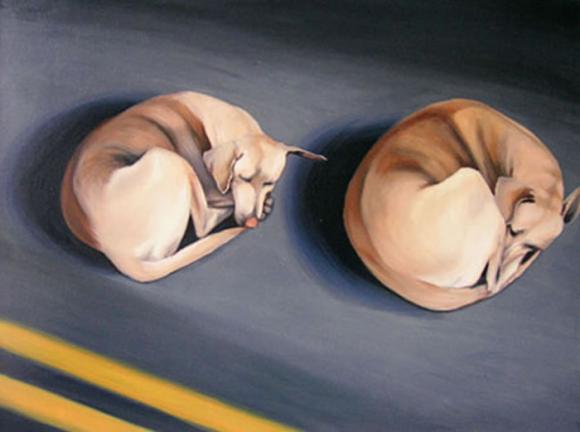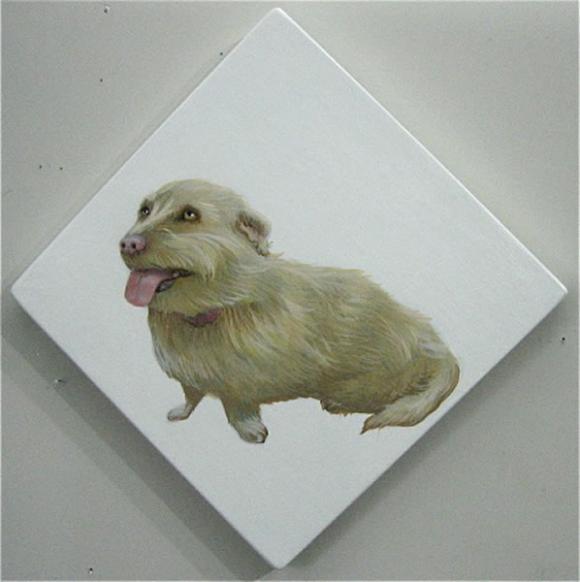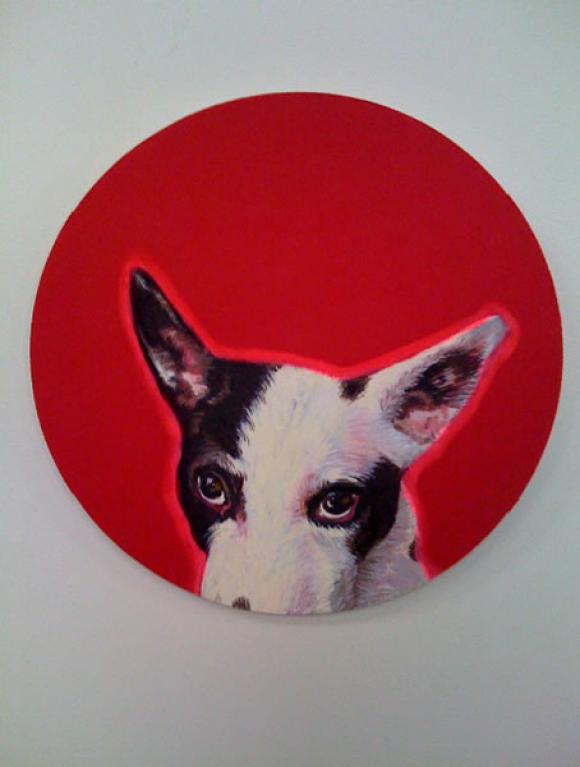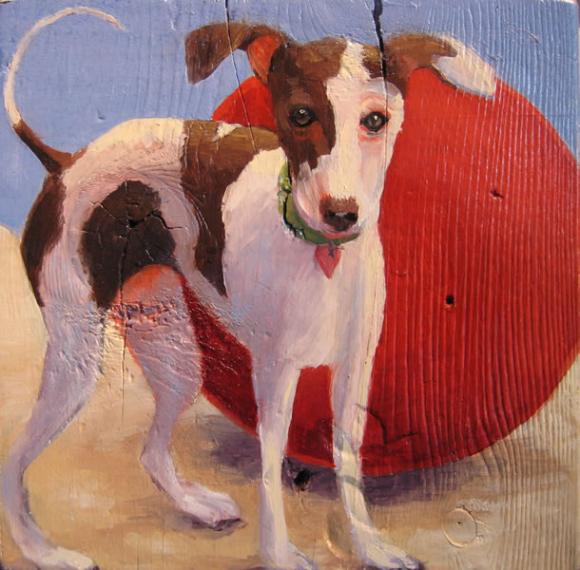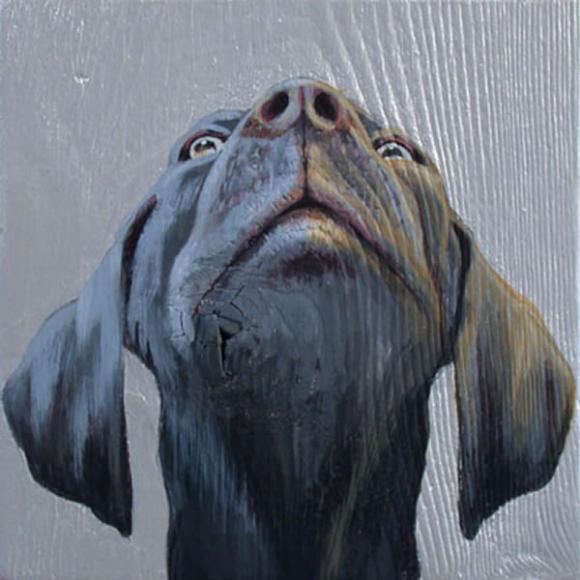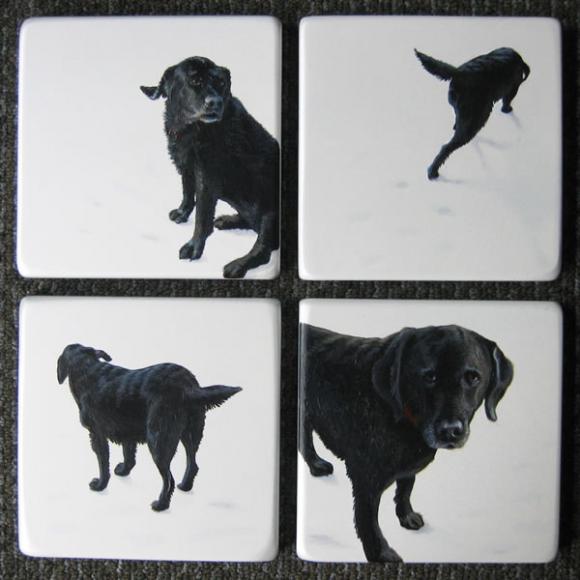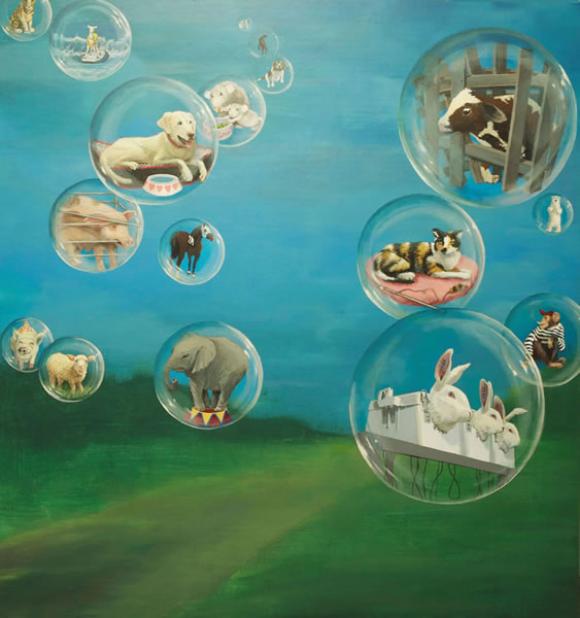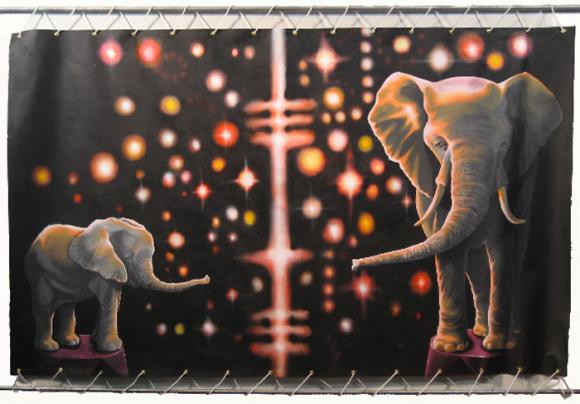Tiere spielen in unserem Leben eine wichtige und komplexe Rolle. Die einen verhätscheln wir als Haustiere, die anderen betrachten wir als Ware und Rohstofflieferant. Jane O'Hara - ich habe ihre künstlerische Arbeit im letzten Blogbeitrag vorgestellt - kuratiert eine Ausstellung, in der sie dreizehn KünstlerInnen versammelt, deren Arbeiten einerseits Liebe und Respekt für die Tiere vermitteln, andererseits aber auch unsere Schuld an den verübten Verbrechen an Ihnen thematisieren.
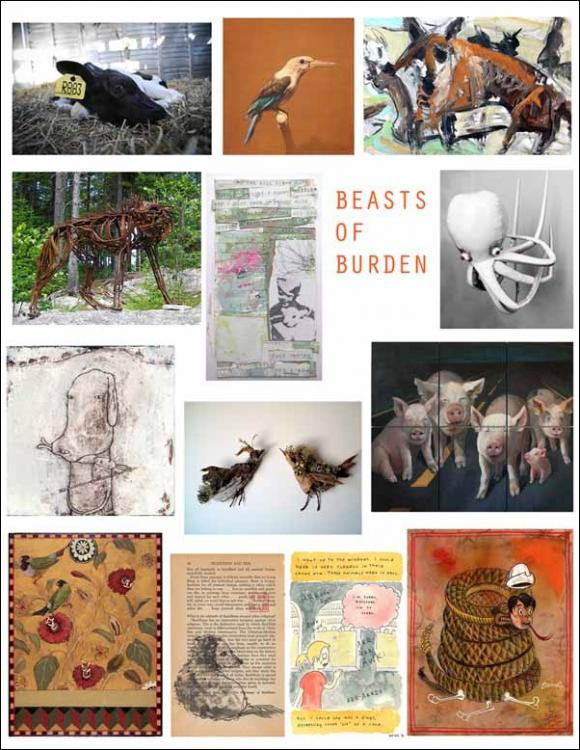
Ausstellung Beasts of Burden, Abbildung von Dog Art Today
Die Ausstellung "Beasts of Burden" findet vom 13. März bis zum 5. Mai 2014 in Boston statt. Die eingeladenen KünstlerInnen arbeiten in ganz unterschiedlichen Medien. Ich möchte diejenigen vorstellen, die sich in ihrer Arbeit speziell auf Hunde und Wölfe beziehen.
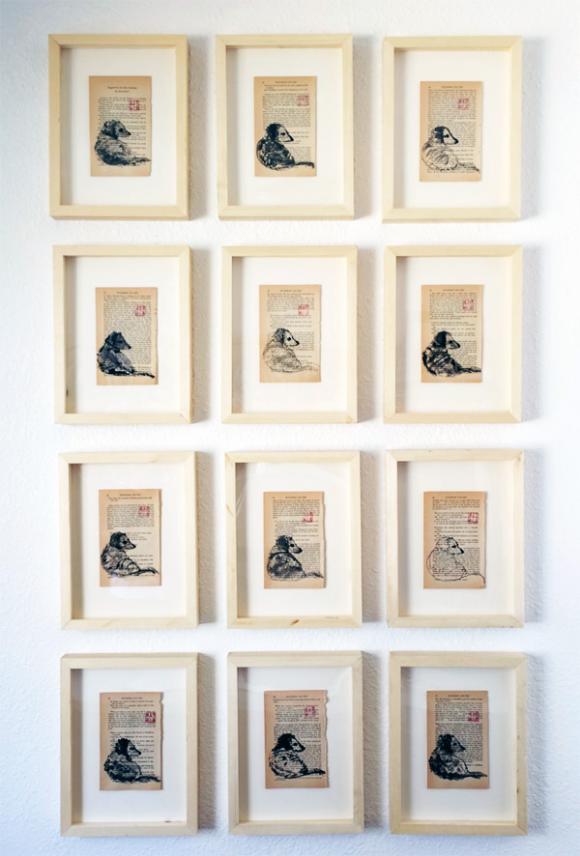
Twelve dox ZENS © Moira McLaughlin
Moira McLaughlin zeichnet ihren verstorbenen Dackel Darby mit Pinsel und Tusche auf die Seiten eines buddhistischen Buches. Sie gebraucht eine alte künstlerische Tradition sowie die philosophische Praxis des Zen Buddhismus, um ihre Möglichkeiten zu erkunden, mit Trauer, Verlust und Vergänglichkeit umzugehen. Wenn Sie mehr über Moira McLaughlins Arbeit Twelve dox ZENS und über die Geschichte ihres Blogs Dog Art Today erfahren wollen, empfehle ich Ihnen ein Interview, das die Fotografin und Bloggerin Katherine Carver hier mit ihr geführt hat.
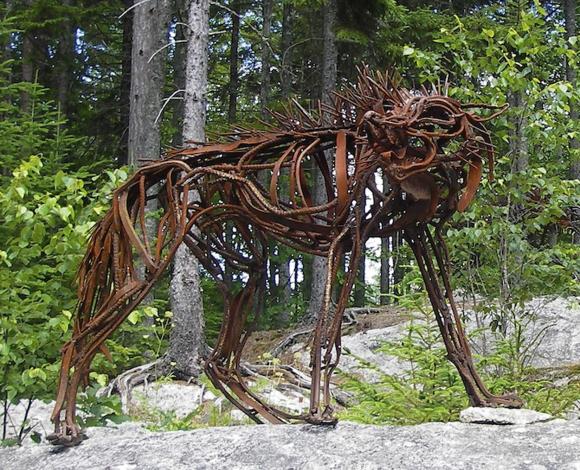
Stahlskulptur: Fierce Wolf © Wendy Klemperer
Wendy Klemperer untersucht in ihren großen Stahlskulpturen die Körperlichkeit und Körpersprache der Tiere, um ein Gefühl oder einen Zustand auszudrücken, um Bewegung in Emotion zu übersetzen.
Besonders interessant an ihren Skulpturen finde ich die Verwendung vorgefundener Materialien, die durch ihre Form, Stärke, Krümmung die Skulptur mitgestalten und durch ihre rohe unmittelbare Qualität den expressiven Charakter der Werke verstärken. Klemperer findet den Industrieabfall auf Schrottplätzen, recycelt ihn zu Kunstwerken, wandelt ihn in lebendige Form um. Selbst die Landschaft, die durch die Zwischenräume der Skulptur dringt, bestimmt das Werk mit.
Hunde- und hasenähnliche Wesen bevölkern Rebecca Doughtys kleine, nahezu monochrom angelegte Formate. Sie nehmen menschliche Rollen ein, erzählen emotional und psychologisch aufgeladene Geschichten durch vorsichtige Gesten oder durch die Blicke, die zwischen ihnen, ihrem Schöpfer, und dem Betrachter kursieren.
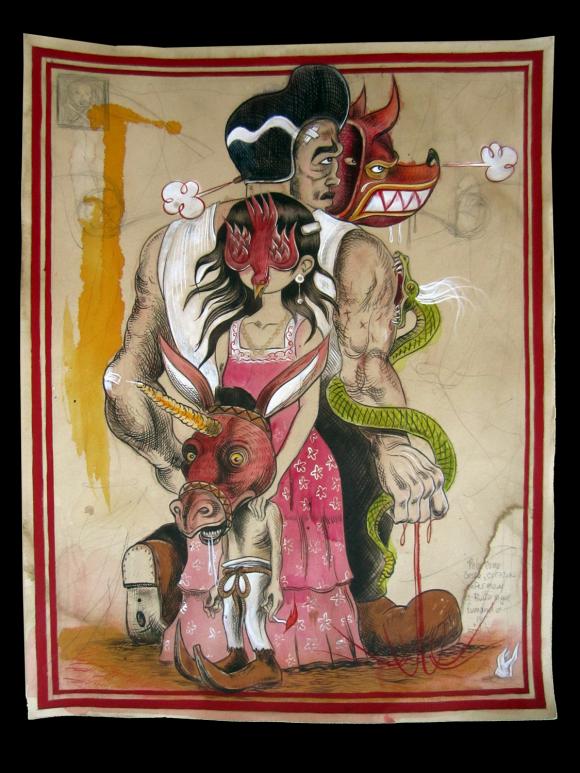
Pelo Como Casco Corozon Inferno y el Burro Sigue Fumando © Raul Gonzalez III
Auch Raul Gonzales III verwendet Tiere um politische und kulturelle Konflikte zu hinterfragen, ein breites Spektrum menschlicher Emotionen und Erfahrungen zu untersuchen.

Rabbit, Rabbit, Fox, Rabbit © Gedas Paskauskas
Unglaublich locker, elegant und mit scheinbarer Leichtigkeit gemalt sind die geheimnisvolle Tierformen von Gedas Paskauskas. Er stellt die Beziehung zwischen Jäger und Beute, Fuchs und Hasen dar: ihre Konfrontation und den Kampf ums Überleben.
Jane O'Haras Arbeit "Sacrifice" ist für mich ein besonders gut gelungenes Beispiel dafür, wie tierrechtsrelevante Belange, künstlerisch umgesetzt werden können. Sie hat dafür Tiere ausgesucht, die millionenfach für menschliche Interessen getötet oder gequält werden. Die Logos bekannter Unternehmen auf den Gewändern der Tiere verweisen auf die Verursacher:
So trägt der Schimpanse ein T-Shirt der Columbia University, die grausame Tierversuche an Primaten durchführt. Die Katze trägt ein Gewand mit dem Logo von March of Dimes, einer US-amerikanischen Wohltätigkeitsorganisation, die die Gesundheitssituation von Neugeborenen verbessern will. Ein Teil der Spendengelder wird für Vivisektion an schwangeren Tieren verwendet. Der Elefant kritisiert am Beispiel von "The Greatest Show on Earth" des Ringling Bros Circus die Dressur von Wildtieren. Das Procter & Gamble Logo auf dem Gewand des Kaninchens steht ebenso für grausame Tierversuche, wie das Pfitzer-Logo auf dem Gewand der Ratte. Die Kuh, das Schwein und das Huhn weisen auf McDonalds, Kenntucky Fried Chicken und Smithfield Farms und deren tierquälerische Art der Fleisch- und Eiproduktion hin. Der Hund trägt das Logo von Iams Dog food, die Experimente an Hunden und Katzen durchführen. Eine genauere Beschreibung dieser Arbeit finden sie hier.
Da auch ich sehr viel darüber nachdenke, wie man tierrechtsrelevante Themen mit den Mitteln der Kunst umsetzen kann, war ich sehr froh, dass sich Jane O'Hara einverstanden erklärt hat, mit mir ein Interview zu Ihrer Arbeit als Künstlerin und Kuratorin zu führen:
Portraits of dogs are often perceived as cute and kitsch. Artists who paint dogs are artistically not taken seriously. What is your strategy to avoid this kisch trap?
I agree, these stereotypes do exist, but fact is, i happily do paintings of people's animal companions as well as painting the animals in my other artwork. I try to capture something unique and specific about each animal I paint. I want to honor all the experiences the animals of our planet experience, whether its love, joy and humor or the lack of compassion. I look for a way to express the emotional depth of the animals' situation with composition, color and rendering.The people who want me to paint their animals enjoy letting me have the freedom to do that.
Beside portraits of animals you also paint pictures with animal rights subjects. What startet this development?
This interest in painting animals in all situations can be traced back to my relationship with my younger brother with intellectual disabilities, and my dogs. Because of these relationships I gained a great respect for communication beyond social surfaces and words. As I've learned more about the animal condition i am struck by the duality it poses—our insensitivity to animals raised in captivity and treated inhumanely, versus the casting of human traits onto our beloved pets. I find it both disturbing and intriguing so it inspires me to find a way to communicate this through painting.
Do you think that painting respectively realistic painting is actually able to represent or critizise all kinds of animal abuse and exploitation. Is painting not always trivializing or playing down the cruelity? And which artistic way do you choose to avoid this?
A painting in itself is not going to stop the horrors that exist in the world for animals. But animals cannot speak for themselves. They are either hidden from view as mere commodities or at the other extreme unnaturally doted on and awarded traits that have more to do with us than them. With my efforts through painting to capture the heart and soul of the animals, my ultimate goal is to deliver viewers into a world where animals speak for themselves from a place of honesty about their state and our relationship to it.
Do you consider humor or irony as an artistic possibility to handle animal rights issues?
I do use humor and irony in my work. Its the type of person I am when not painting so it stands to reason that is how i create as well. I enjoy trying to open peoples eyes using humor and irony . The graphic expression of the dark things that go on in many cases brings the reaction of closed eyes. On a deeper level ...in the abstract...i truly am amused, intrigued and concerned by humans ability to hold these conflicting sensibilities- doting and obsessing over their dogs yet eyes firmly shut to the dark truth of agribusiness or animals in entertainment,clothing, or experiments.
As an advocate for animal rights and a vegan you critizise in your work „Sacrifice“ McDonalds and KFC and their meat production. Should we not also critizise the consumer? Is it generally possible to love animals without being a vegan?
Yes, i think it is possible to love animals without being vegan. It goes back to what i was saying about the ability people have to compartmentalize. The love felt for animal companions is real, and the blind eye turned towards animals as commodities is the result of a brainwashing we all have received. I believe that most people have it in their hearts to love all animals and if i can help make visible some invisible animals with my paintings that makes me extremely happy! If my paintings only serve to bring the joy of animals to light that has great value too, as I believe love, not blame and humiliation, opens hearts and consciences. If my work helps to open the heart I feel there is success. Now that I have learned more about what goes on with animals, I do believe it's my responsibility as consumer not to add to the suffering of animals. I feel a lightness in not lying to myself about animals and hope through my artwork to share some of this awareness.
You have chosen highly diverse artists for your exhibition "Beasts of Burden". What are your criteria for this selection?
Finding the artists came easily as the idea for the show unfolded to me. My own artwork's core is in playing with the schizophrenic relationship society has with animals. This also has expanded to be the theme of the exhibition. Artists seemed to appear in front of me as the theme of the show became more clear. There are so many ways in which animals are used in art; the morbid beauty of taxidermy, animals' lives and conflicts in nature, words and pictures used to explore personal issues which include guilt about animals, pages of Buddhist text probing themes of detachment, grief and impermanence with a deceased animal, exploration of cultural and political conflict enlisting animals as stand- ins for a spectrum of human emotions, within dreams and prose, representing the contradiction between our declared love and the violence we inflict on them, documenting the horrors of the animal ghosts through photography, pure celebration of their beauty, humor and how animals are used metaphorically. The artwork was there and I was fortunate to interest the artists in my idea for the show.
Considering your personal experience: How do you raise awareness for animal rights issues?
As a vegan sometimes people are curious and ask questions. As a decent cook I spread the happy news that it isn't necessary to involve animals in the making of great food. On facebook I repost all sorts of animal videos from cute and funny to deeply disturbing. But as a painter I depict animals in unusual compositions or inhabiting other-worldly landscapes. In them I want these animals to confront the viewer, invoking unease and raising questions, as well as playfulness and joy. My method for raising awareness of animal rights issues is to open my own heart so I can paint truthfully.
Ich danke Jane O'Hara ganz herzlich für diese ausführlichen Überlegungen und die Zeit, die sie sich genommen hat, um meine Fragen zu beantworten!

